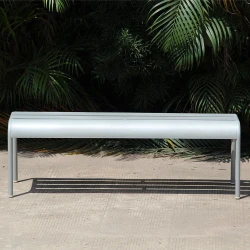Innovative Trends in Public Furniture Design for Modern Cities
2024-09-21
As cities become more populated and urban spaces more valuable, the role of public furniture has transformed from basic utility to innovative design that enhances the experience of city life. Today, public furniture is being reimagined to meet the changing needs of modern urban dwellers. In this post, we’ll explore the latest trends in public furniture design and how they are shaping the future of urban spaces.
1. Smart Public Furniture
With the rise of smart cities, public furniture is becoming more technologically advanced, integrating digital features that enhance both functionality and user experience. Smart public furniture includes elements like solar-powered benches, Wi-Fi hotspots, and charging stations for devices.
- Solar-Powered Benches: In many cities, benches are now equipped with solar panels that not only provide energy for built-in lighting but also allow users to charge their smartphones or other devices while they relax outdoors.
- Interactive Elements: Some public furniture now features touchscreens or interactive displays that provide information about the surrounding area, including public transportation schedules, local events, and maps.
- Wi-Fi Enabled Seating: With the increasing demand for connectivity, many parks and public spaces now offer Wi-Fi-enabled seating areas, allowing people to work, study, or simply stay connected while enjoying the outdoors.
2. Sustainable and Eco-Friendly Design
Sustainability is at the forefront of modern public furniture design. Cities are increasingly focused on reducing their carbon footprint and creating eco-friendly urban spaces, and public furniture plays a key role in this effort.
- Recycled Materials: More public furniture is being made from recycled or reclaimed materials, such as plastic, metal, and wood. This not only reduces waste but also gives new life to materials that might otherwise end up in landfills.
- Green Infrastructure: Public furniture that incorporates natural elements, such as living walls, planters, or seating with integrated greenery, helps to soften the urban landscape and support biodiversity in cities.
- Durability and Longevity: Sustainable public furniture is designed to be durable and weather-resistant, reducing the need for frequent replacement and minimizing waste. This is especially important in high-traffic areas where furniture sees constant use.
3. Modular and Flexible Furniture
As urban spaces become more dynamic, public furniture is evolving to be more flexible and adaptable. Modular furniture systems are becoming increasingly popular, allowing cities to easily rearrange or expand seating and other elements to suit different events or needs.
- Moveable Seating: Some public furniture systems are designed to be moveable, allowing users to rearrange seating to suit their preferences or group size. This flexibility makes public spaces more adaptable to different activities, from casual lounging to group gatherings.
- Modular Units: Modular public furniture pieces can be combined in various configurations, making it easy to expand seating for large events or create intimate, quiet corners in a park. This adaptability ensures that public spaces remain versatile and can meet the changing needs of the community.
4. Ergonomics and Comfort
Public furniture is no longer just functional; it is now designed with the comfort and well-being of users in mind. Ergonomically designed benches and seating encourage relaxation and make outdoor spaces more welcoming.
- Contoured Seating: Benches with contoured seats and backrests provide better support for users, making long periods of sitting more comfortable. These designs are especially important in areas where people gather to relax or enjoy public performances.
- Inclusive Design: Public furniture is increasingly being designed with inclusivity in mind. This includes seating that accommodates people of different ages and abilities, such as benches with armrests and seats at various heights for ease of use by the elderly or disabled.
- Shaded and Weather-Protected Seating: As outdoor environments can be affected by weather conditions, furniture that offers shade or protection from rain is becoming more common. This ensures that public spaces can be enjoyed year-round, regardless of the weather.
5. Artistic and Unique Designs
Public furniture is also becoming a form of public art. In many cities, designers are creating unique, artistic pieces that serve as both functional furniture and sculptural works of art, enhancing the cultural and aesthetic value of public spaces.
- Sculptural Benches: In urban parks and plazas, benches and seating are being designed as eye-catching sculptures, adding a creative touch to the environment and making public spaces more visually appealing.
- Interactive Art Pieces: Some public furniture is designed to engage users in playful ways. For example, swings, rotating benches, or furniture that responds to movement invite people to interact with the space in a fun and dynamic way.
- Cultural Expression: Many cities use public furniture to reflect their local culture or history. For example, furniture with motifs, colors, or designs inspired by the city's heritage can create a deeper connection between the space and its residents.
Conclusion
Public furniture is undergoing a transformation, evolving to meet the needs of modern cities while enhancing the experience of urban life. From smart benches that offer charging stations to eco-friendly designs that promote sustainability, public furniture is becoming more innovative, flexible, and inclusive. As cities continue to grow and change, public furniture will play a critical role in creating vibrant, livable spaces that serve the community in new and exciting ways.



